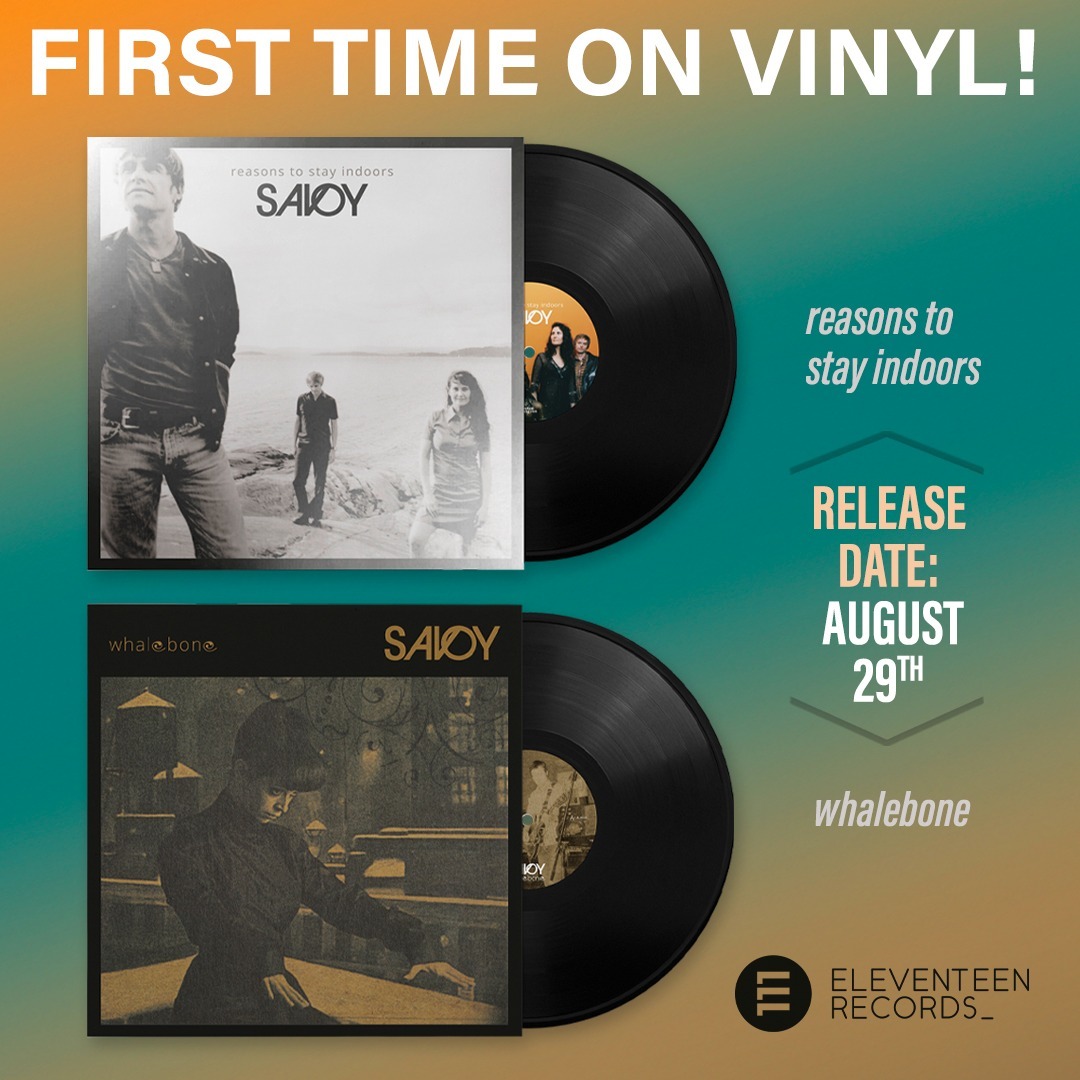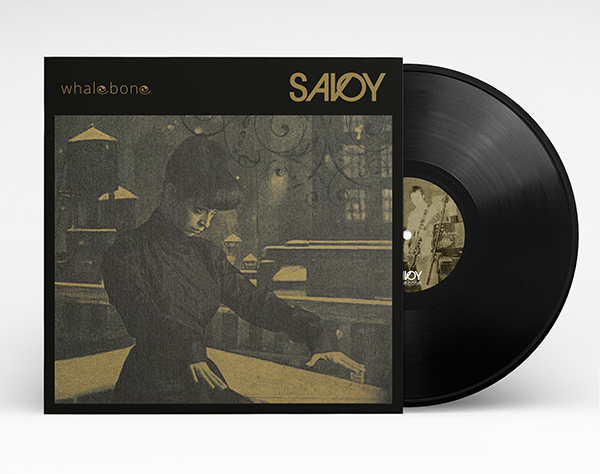Monday 30 June 2025
Savoy releasing 'Reasons to Stay Indoors' and 'Whalebone' (formerly 'Savoy') on vinyl

Following the digital release of Reasons to Stay Indoors (2001) and Whalebone (2004) on all streaming platforms last fall, Savoy are pleased to announce the 180g vinyl releases of our fourth and fifth studio albums. Released on the band’s own Eleventeen Records label, both albums have been remastered at Joe Lambert Mastering, while Tom Korsvold has overseen the revised artwork.
Release Date: 29 August 2025 - Preorder Now
Savoy is the band Paul Waaktaar-Savoy (guitar, vocals and keyboards) formed with his wife Lauren (guitar and vocals), and Frode Unneland (drums and vocals), following a-ha’s separation in 1994. As the guitarist and songwriter in the globe-conquering Norwegian act, the man behind hits including ‘Take On Me’, ‘The Sun Always Shines On TV’, ‘Hunting High And Low’ and ‘The Living Daylights’ needs little introduction, but it should be noted that Savoy is a democratic unit, with Lauren’s songwriting and voice integral to the band’s sound, while Frode’s contribution as both a drummer and a versatile vocalist shouldn’t be understated. To date, the award-winning indie pop trio have cut eight albums – including a two-disc retrospective – and their most recent LP, Under, was released to high acclaim last year.
Once a-ha reformed in 1998, prolific songwriter Paul admiringly managed to maintain a dual career with Savoy, and a total of six studio albums were released between 1999 and 2005. There was also the small matter of adjusting to parenthood following the birth in 1999 of the couple’s son, True August, whom they affectionately nicknamed Augie. “Those years were insane, and I’m still not quite sure how we managed to do that,” says Paul. “But the songs kept coming without, you know, having to force them, and I totally changed my working patterns. Instead of sitting up all night until the early morning in the studio, I would sort of try to limit myself to four hours of intense work. So I would sort of prepare during the day while I was playing with Augie or whatever and then go in and really have a clear picture of what I wanted to do. So in a way it turned out to be a good thing because it left you with more of a spontaneous feeling in the music.”
As with previous albums, Paul and Lauren wrote and produced all of the songs on Reasons To Stay Indoors. “We worked on our own as usual,” says Paul, “and did the drums in New York at Sorcerer Sound. We had ambitions of making parts of the album quite orchestral, so I would say half the album has the very full production with strings and everything. I think it was the first time we’d worked with Joe Martin as a string arranger – up until that point, I’d done most of that myself. And when it came to the mix, there was a different group of people. Michael Ilbert did a lot, and Zed Nagrano, who was a funny character, helped out a lot on a couple of tracks, like the title track, and also Jason Corsaro, who had mixed half of the previous album, Mountains Of Time.
The birth of Paul and Lauren’s son was a major milestone, and the couples’ joy naturally fed into some of their new songs, notably ‘Against The Sun’, ‘Once Upon A Year’, and ‘Five Million Years’. “Apart from the fact that it drastically changed our lives, and obviously turned it upside down, it marked the end of the ego trip,” says Paul. “The songwriter part of me was still looking for anything to use as a vehicle for the next song, so this became a huge area of inspiration, something new to write about.”
As you’d expect from a man who’d been living in New York since 1988, the co-writer of ‘Manhattan Skyline’ continued to find inspiration in his adopted city. The epic title cut, a personal favourite of Paul’s, elicits the solitude of higher education living, mentioning the prestigious Colgate University in Hamilton. Elsewhere, ‘Face’ stemmed from his wonderment of the Big Apple’s breathtaking panoramas as the couple journeyed downstate.

As Paul explains, the original album artwork couldn’t be sourced: “One of the unusual things with Savoy is that we always recorded the albums first before we went out to look for a recording deal, so a lot of our albums are on different labels. And I see now, going back, releasing all these albums, I find that all the art departments that we worked with are long gone. And also, with external design firms, people have changed and moved on to other things. So it’s really a reflection on the state of the music business.”
The new cover art boasts an alternative shot by original photographer Sebastian Schmidt, and has been laminated in silver, a nostalgic nod to the debut record by Steppenwolf that Paul owned as a child. In today’s digital age, he remains a big fan of vinyl. “I can see why people want something physical,” he says. “The artwork makes a difference when listening, and if you have a decent stereo system the sound will grab you in a different way.”
For the follow-up to Reasons To Stay Indoors, the band broke with tradition and brought in an outside producer in Madrugada member Frode Jacobsen, who helmed four of the tracks. Guests included the boys’ choir Sølvguttene (whose voices can be heard on the high school drama of ‘Shooting Spree’), and Ours frontman Jimmy Gnecco, who took on ‘The Breakers’, a song originally cut during the troubled sessions for a-ha’s seventh studio album, Lifelines.
Although Paul welcomed the stress-free surroundings that Savoy offered away from a-ha’s internal conflicts, there was an underlying sadness on the band’s fifth studio album, which was noticeably darker in tone. “Whalebone was a mix of great joy since we had our little boy, and we were obsessed by that,” says Paul, “but at the same time, great sorrow since Lauren's sister fell ill and succumbed to her illness in the middle of it. So, yeah, it knocked us off our feet and left us numb. We didn't know how to deal with it at all.”
Like its predecessor, Whalebone wasn’t short of New York references. While the city was still coming to terms with September 11, Paul’s appreciation of its beauty was unwavering, notably on the ephemeral ‘Watertowers’ and its vivid snow-capped evocations. “Manhattan is especially magical when it snows,” says Paul. “Every winter you’ll have one or two Nor’easters that dump a ton of snow. Ten million people but everything’s dead quiet.” It’s an unashamedly Beatles-esque moment, but Paul also acknowledges the influence of The Band on the record, citing ‘Bovine’ – which comically depicts a lazy farmer attempting to authenticate his livelihood with various agricultural purchases – as an obvious example. “To escape the craziness of Manhattan we bought a place in Woodstock and spent most weekends up there: planting stuff, seeing things grow, checking on the wildlife,” he explains. “That song must’ve been inspired by all that. And Levon Helm lived a few minutes away!”

Arguably, the cornerstone of the record was the single ‘Whalebone’, which was also featured in the award-winning film, Hawaii, Oslo. It notably recycled to great effect a section of the lyrics from a-ha track ‘Locust’. “It was written the same way ‘Velvet’ was written, ignited and born out of Lauren’s verse which I absolutely loved,” says Paul, “and the chorus I wrote out of that made me think of ‘Locust’ for some reason, but this time I could expand on those lyrics.”
With this new gatefold vinyl reissue, the band have taken the opportunity to not only revise the artwork (utilizing a somewhat macabre shot that was originally included in the two-disc digipak version), but also rename the self-titled album. “I always loved the art film that Jason Brandenberg did for ‘Isotope’,” says Paul, “and so we decided to take to use a couple of stills from that film as part of the artwork. When it comes to the title, we always talked about the album at the time as Whalebone, so now we’ve just made it easier!”
